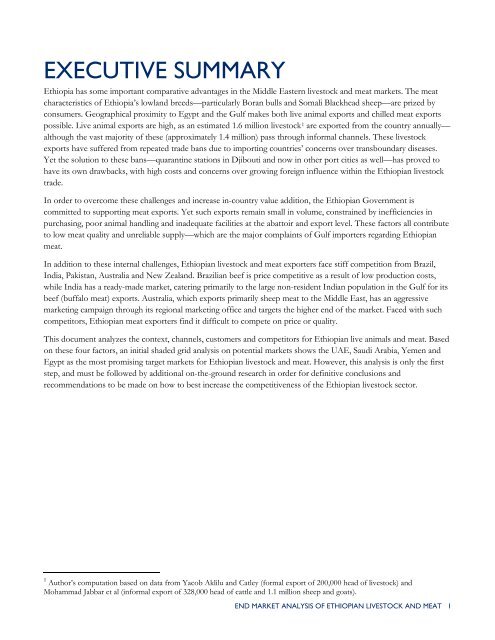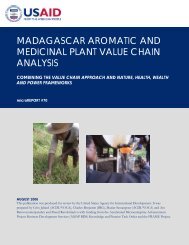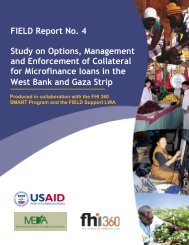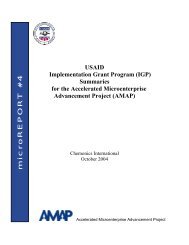End Market Analysis of Ethiopian Livestock and ... - USAID Microlinks
End Market Analysis of Ethiopian Livestock and ... - USAID Microlinks
End Market Analysis of Ethiopian Livestock and ... - USAID Microlinks
You also want an ePaper? Increase the reach of your titles
YUMPU automatically turns print PDFs into web optimized ePapers that Google loves.
EXECUTIVE SUMMARY<br />
Ethiopia has some important comparative advantages in the Middle Eastern livestock <strong>and</strong> meat markets. The meat<br />
characteristics <strong>of</strong> Ethiopia’s lowl<strong>and</strong> breeds—particularly Boran bulls <strong>and</strong> Somali Blackhead sheep—are prized by<br />
consumers. Geographical proximity to Egypt <strong>and</strong> the Gulf makes both live animal exports <strong>and</strong> chilled meat exports<br />
possible. Live animal exports are high, as an estimated 1.6 million livestock1 are exported from the country annually—<br />
although the vast majority <strong>of</strong> these (approximately 1.4 million) pass through informal channels. These livestock<br />
exports have suffered from repeated trade bans due to importing countries’ concerns over transboundary diseases.<br />
Yet the solution to these bans—quarantine stations in Djibouti <strong>and</strong> now in other port cities as well—has proved to<br />
have its own drawbacks, with high costs <strong>and</strong> concerns over growing foreign influence within the <strong>Ethiopian</strong> livestock<br />
trade.<br />
In order to overcome these challenges <strong>and</strong> increase in-country value addition, the <strong>Ethiopian</strong> Government is<br />
committed to supporting meat exports. Yet such exports remain small in volume, constrained by inefficiencies in<br />
purchasing, poor animal h<strong>and</strong>ling <strong>and</strong> inadequate facilities at the abattoir <strong>and</strong> export level. These factors all contribute<br />
to low meat quality <strong>and</strong> unreliable supply—which are the major complaints <strong>of</strong> Gulf importers regarding <strong>Ethiopian</strong><br />
meat.<br />
In addition to these internal challenges, <strong>Ethiopian</strong> livestock <strong>and</strong> meat exporters face stiff competition from Brazil,<br />
India, Pakistan, Australia <strong>and</strong> New Zeal<strong>and</strong>. Brazilian beef is price competitive as a result <strong>of</strong> low production costs,<br />
while India has a ready-made market, catering primarily to the large non-resident Indian population in the Gulf for its<br />
beef (buffalo meat) exports. Australia, which exports primarily sheep meat to the Middle East, has an aggressive<br />
marketing campaign through its regional marketing <strong>of</strong>fice <strong>and</strong> targets the higher end <strong>of</strong> the market. Faced with such<br />
competitors, <strong>Ethiopian</strong> meat exporters find it difficult to compete on price or quality.<br />
This document analyzes the context, channels, customers <strong>and</strong> competitors for <strong>Ethiopian</strong> live animals <strong>and</strong> meat. Based<br />
on these four factors, an initial shaded grid analysis on potential markets shows the UAE, Saudi Arabia, Yemen <strong>and</strong><br />
Egypt as the most promising target markets for <strong>Ethiopian</strong> livestock <strong>and</strong> meat. However, this analysis is only the first<br />
step, <strong>and</strong> must be followed by additional on-the-ground research in order for definitive conclusions <strong>and</strong><br />
recommendations to be made on how to best increase the competitiveness <strong>of</strong> the <strong>Ethiopian</strong> livestock sector.<br />
1 Author’s computation based on data from Yacob Aklilu <strong>and</strong> Catley (formal export <strong>of</strong> 200,000 head <strong>of</strong> livestock) <strong>and</strong><br />
Mohammad Jabbar et al (informal export <strong>of</strong> 328,000 head <strong>of</strong> cattle <strong>and</strong> 1.1 million sheep <strong>and</strong> goats).<br />
END MARKET ANALYSIS OF ETHIOPIAN LIVESTOCK AND MEAT 1





